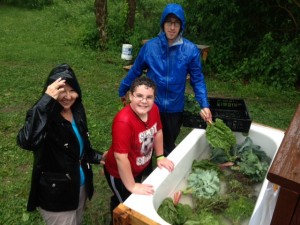Water has been on my mind lately. Mainly because I was worried that my plants weren’t getting enough of it during the final weeks of May. Until a few days ago, the top few inches of soil in the garden were turning dusty dry and the flow of the creeks running alongside my garden had turned from a gush into a trickle. While neighboring farms were busy irrigating their crops, I was busy doing a rain dance because…full disclosure here…I don’t have an irrigation system set up yet. I have a long to-do list for the farm, and setting up irrigation has been on that to-do list for a long time. I kept shuffling it to the bottom of the list because Mother Nature has been providing consistent rain or thundershowers (or snow) since my first seeds and plant babies went out into the field in March. So instead of looking my irrigation (or lack of irrigation) problem in the eye, I focused on other farm projects. Also, I have to admit, irrigation is a topic that makes my head spin, which is probably why I have procrastinated so long.
To irrigate crops, you need a water source and power to deliver the water to the crops. While I’m lucky that I have creeks bordering three sides of my farm, they don’t always hold water consistently throughout the year, and I don’t have an electric source anywhere near my field, so I need to have an alternative power source to pump water from the creeks. Another disclosure – I would rather not have to water at all. If I can get all of my water in the form of rain, it saves me a lot of time and worry. Plus, plants tend to be better at growing deep, water-seeking roots if you don’t water them too much. If the surface of the soil is consistently wet from regular irrigation, the plants will form shallow roots that stay near the surface and easily dry out when they aren’t irrigated. Normally, here in Kentucky, you can bet on warm rains throughout the summer, but we have experienced drought years, and who knows what will happen this summer, so I’m biting the bullet and buying irrigation equipment in case we have an unusually dry summer. Now I’m tackling the confusing-to-me subjects of water pressure, friction loss, filtration, and the puzzle of putting together pumps, fittings, pipes, hoses, valves, and nozzles. On top of all that, I have struggled to find a local irrigation supply store that carries agricultural irrigation products for small scale growers. There sure do seem to be a lot of lawn irrigation contractors and suppliers out there, but not a lot of options for people growing things other than grass. The nearest agricultural irrigation store I could find was in Lexington. I could try and order everything online, but I really wanted to talk to an expert and see how all those little fittings, hoses, and whoozeewhatsits go together before I purchased them. So, earlier this week after some hot days with no rain, I decided to drive to Lexington and talk to the fine people at Kentucky Irrigation. Now I’m the proud owner of some drip tape, a filter, pressure regulator, and various fittings. I still need to purchase a pump and a large diameter hose or pipes to deliver water from the pump up the field, but all of that can wait a little longer because my rain dance paid off – on Wednesday, we received an inch of rain. As luck might have it, most of it fell during the few hours we have to harvest vegetables for our Wednesday farmers market, but I’m not complaining. The plants are thriving now in moist soil and I get to procrastinate my irrigation problem for a little longer.

